Disability is a complex phenomenon — it represents the interaction between a person’s physical abilities, the activities they need to perform, and the architectural barriers within their surroundings. Each individual experiences this differently. Two people with the same impairment may describe their limitations in completely different ways. The blind navigate a world that is profoundly different from that of someone who is deaf — and both deserve spaces designed with equal accessibility in mind.
According to national reports, 19% of adults between ages 16 and 64 and 42% of those 65 and older live with a physical disability that affects their daily activities. These realities make it clear: accessibility isn’t just a senior issue — it’s a human one.
Building for All Ages and Abilities
This situation applies to everyone — adults, children, and individuals with special needs. The building industry must work together to ensure that every living environment meets essential human needs: safety, affordability, and structural integrity.
A truly accessible home supports privacy, belonging, control, safety, and security — the cornerstones of quality of life. These values should always guide the planning of any barrier-free design.
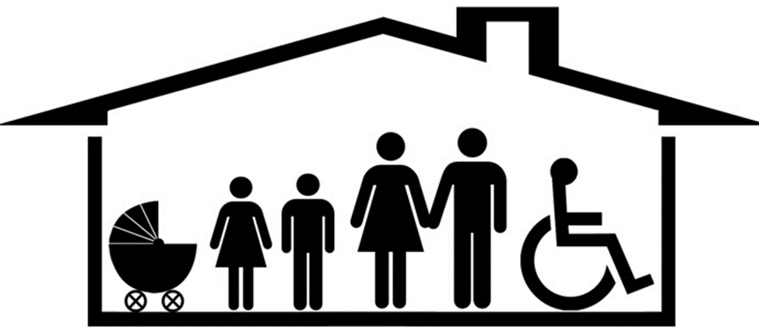
Common Barriers in Traditional Homes
Most traditional homes are full of hidden obstacles that restrict maneuverability for people with disabilities. These challenges become even more pronounced when mobility aids like walkers or wheelchairs are required.
Common architectural barriers include:
-
Steps at entryways with no alternative access
-
Narrow doorways and hallways with tight turns
-
Cramped bathrooms with poor fixture placement
-
Inaccessible outdoor spaces and patios
-
Kitchens that lack clear floor space or proper reach ranges
-
Hard-to-operate door hardware that requires grip strength and coordination
These design flaws can turn an ordinary house into a daily struggle for anyone with mobility limitations.
The Evolution of the Accessible Home
Accessibility has evolved far beyond grab bars and ramps. Modern accessible design is now built into the foundation of the home — seamlessly integrated rather than added as an afterthought.
This shift reflects the growing adoption of Universal Design, a concept that focuses on creating spaces, products, and environments usable by as many people as possible, regardless of age, ability, or circumstance.
Universal Design isn’t about making a home look institutional or medical. It’s about creating beauty, comfort, and functionality that everyone can enjoy — a design approach that feels natural, not clinical.
When done well, Universal Design improves safety and accessibility for every occupant and guest, often in ways that are practically invisible.
Accessible Home Design in Austin, Texas
For those in the Austin area seeking accessibility improvements, T-Square Company offers over 30 years of experience in barrier-free remodeling and accessible home design.
T-Square specializes in customized disability home modifications for residents of all ages, including:
- Expert and professional home assessments
-
Wider doors and hallways
-
Accessible bathrooms and roll-in showers
-
Barrier-free kitchens
-
Ramped entrances and zero-threshold transitions
-
Stair lifts, elevators, and vertical platform lifts
-
Fully accessible rooms designed to each client’s needs
Every design/build project begins with a clear understanding of the client’s abilities and goals, ensuring that the design solutions enhance both independence and comfort.

Meet David L. Traut, CAPS
David L. Traut, CAPS, owner and president of T-Square Company in Austin, Texas, is part of a select group of professionals nationwide who have earned the Certified Aging in Place Specialist (CAPS) designation.
This certification, offered through the National Association of Home Builders (NAHB) in collaboration with AARP, recognizes remodelers and builders trained to meet the unique needs of older adults and individuals with disabilities.
David is also certified in Universal Design in both the United States and Australia. Drawing on decades of expertise, he recently published Age in Place at Home: Adapting the Home Environment for All Generations, a comprehensive guide that explores the role of Universal Design in creating safe, accessible homes. David wrote this book as a means to help families through difficult times once their homes lacked optimal livability.
📘 Age in Place at Home takes readers room by room, explaining practical modifications that enhance safety, accessibility, and independence. The book is available now on Amazon.
Living Comfortably, Safely, and Independently
Never fear — almost any existing home can be modified to overcome accessibility challenges. With proper planning, professional guidance, and a bit of creativity, you can ensure that every family member enjoys comfort, safety, and freedom of movement.
Following the guidance in Age in Place at Home will not only improve your quality of life — it will also promote equality of access for everyone under your roof.
It just makes good sense.
Tags:
aging in place home modifications,
CAPS certified remodeling in Austin,
certified aging in place specialist,
aging in place design in Austin,
7 principles of universal design,
special needs contractor in Austin,
Austin disability contractors for special needs,
Austin aging in place specialist,
disability access contractor,
accessibility home modifications,
Austin home accessibility solutions,
CAPS-certified remodeling in Dripping Springs,
Dripping Springs special needs contractor,
universal design forever homes,
Universal Design for Disabilities,
Barrier-free designs,
Universal Design Building Professional in Austin,
home accessibility modifications,
safe bathroom design for seniors,
how to age in place
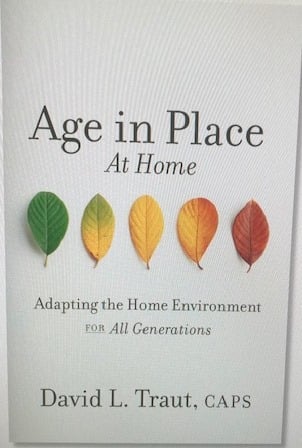
Before and after retirement is an excellent time to prepare the house for what might come next in life—before any significant health issues appear. Choosing to Age in Place earlier in life using Universal Design techniques means a family can longer enjoy the home without obstruction. Their relatives, visitors, and children have peace of mind assured the aging loved ones or the chronically ill are safer living at home.
Everyone planning to remain in their existing home to Age in Place is looking for safety, security, familiarity, ease of use, and comfort. Homeowners and their families should immediately plan for their future housing needs and work from an Aging in Place design checklist. The current housing inventory does not offer the features needed for safety and accessibility in the numbers required to accommodate the growing demand creating a need for home modifications and a niche market. Savvy homeowners and their family have weighed the costs of institutional living compared to their home’s expenses. They also realize the difference in adhering to stringent rules in an institutional facility instead of independently and freely residing in their present home.

The truth is, with professional help, you can adapt almost any home environment to enable you and everyone else in the family to live within it safely to the fullest extent. Aging in place design is not age-related because disability can instantly strike any family member of any age. The need for increased home accessibility is the common thread in any situation. Universal Design or inclusive design is a design and building pathway making homes more accessible to all regardless of their age, mobility, or ability when appropriately used. The Universal Design process offers a seamless path for Aging in Place providing help for those with a sudden disability. It additionally addresses the requirements of special needs families or multigenerational living situations. The elements of Universal Design provide common sense solutions for diverse living conditions.
Regardless of size or ability, people are becoming more familiar with Universal Design and Aging in Place when considering a home remodeling project. Some people use these words interchangeably, but while they are similar in nature, they do differ because of the time they are performed. Both are specific design techniques used in making a home more comfortable and accessible for individuals of different abilities. Universal Design deals more with customized new dwellings and a proactive remodeling approach for people desiring to Age in Place prior to any health issues taking over their life. Comparatively, Aging in Place home modifications strictly involve the remodeling of existing homes to accommodate physical needs brought on by sudden health issues in a reactive manner. The costs for both processes represent a beneficial investment in your home for future needs as opposed to merely spending involving aesthetically pleasing remodeling projects.
As an Aging in Place Specialist and one of Austin's premier Aging in Place contractors, I came to realize existing homes typically contain cramped, twisting hallways with narrow doorways, bathrooms without adequate maneuvering space for decreased usability, kitchens without accessible storage and workspaces, and stepped home entries. These are all common home design flaws. Every one of these common household problematic areas falls short of any Aging in Place design features. Hence, the home building industry has always lacked inclusion for all homeowners with their ever-changing needs.

As a Certified Aging in Place Specialist CAPS(#1636580), I am confident my book, "Age in Place at Home", introduces you to a new way of thinking about your home's future. It acts a guide for solving diverse home needs for all people affected by varying physical conditions and aging. I decided to write this book due to many customer requests for a summation of suggestions to improve their home's accessibility, comfort, usefulness, and sustainability and, ideas they could share with others. The book is full of Aging in Place design guidelines gleaned from witnessing years of shortcomings in traditional homes. I based the information provided on countless past home walkthroughs and home assessments. Within my book, you can discover room-by-room the benefits of using the principles of Universal Design and how to incorporate them periodically throughout your living environment at your own pace. I furthermore guide you through a home, making suggestions for what will increase your and your family's future accessibility. You will notice the chapters involving the bathroom and kitchen are very extensive. They represent the most important rooms to consider when planning to Age in Place. The most utilized rooms in our homes must accommodate all diverse residents and visitors.
Would you please not allow your home to hold you or any of your loved ones captive within its walls. Learn how to enable your home to conform to you and the needs of your family. Please think ahead positively and proactively while preparing for the future. IT JUST MAKES GOOD SENSE.

According to the 2000 census, nearly 50 million people in the United States have some type of disability. Of this group, 6.8 million have a condition that makes it difficult to bathe, dress and get around the inside of their own homes. T-Square Company has the training and knowledge to help with disabilities because we are a Certified Aging in Place Specialist (CAPS).
#accessiblehomes
Tags:
ADA compliant kitchen cabinets,
ADA accessible,
barrier free access,
aging in place remodeling,
ADA remodeling,
aging in place remodels,
ADA kitchen cabinets,
handicap accessible bathrooms,
aging in place construction,
CAPS professional in Austin,
accessible home remodeling,
CAPS remodeling techniques,
disability home remodeling in Austin,
aging in place specialist,
aging in place services,
aging in place design,,
certified aging in place specialist,
handicap remodeling contractors in Austin,
handicap home modifications for disabled,
disability access bathrooms Austin,
universal design ideas,
Austin accessible home remodeling,
certified aging in place consultant in Austin,
aging in place specialist in Austin,
senior aging in place services,
home remodeling for disabled,
home accessibility help in Austin,
home remodeling for disabled in Austin Texas,
wheelchair accessible home remodeling in Austin,
universal design remodeling contractor,
principles of universal design,
disability contractor in Austin,
special needs contractor in Austin,
handicap accessible remodeling,
barrier free remodeling,
handicap accessible home modifications,
disability remodeling,
handicap bathroom remodel,
disability access contractor,
barrier free showers in Austin,
ADA vanity in Austin,
accessible bathroom remodel,
what is ada compliant,
accessible homes,
universal design contractor,
accessible housing,
Austin home remodeling for disabled,
modifying your home for a disabled child,
wheelchair accessible homes,
the basics of aging in place,
barrier free kitchens,
barrier free design,
Austin home accessibility solutions,
Age in Place at Home
When a family's living situation suddenly changes, it may be necessary to make various home modifications to accommodate the new circumstances. This process will in turn create multigenerational homes. The specific modifications required can vary widely based on the nature of the change, but here are some common considerations:
- Additional Bedrooms: If the family is growing or if someone new is moving in, you may need to create additional bedrooms or sleeping areas. This might involve converting a home office, den, or other space.
- Bathroom Accessibility: If there are elderly or disabled family members moving in, you may need to modify bathrooms to make them more accessible. This could include installing grab bars, a walk-in shower, or a wheelchair-accessible sink and toilet.
- Kitchen Modifications: A larger family might require changes in the kitchen to accommodate more people. This could involve adding extra seating, variable-height working surfaces, roll-under ability at the sink or stovetop, increasing storage space, or even expanding the kitchen.
- Safety Features: Depending on the situation, you may need to add safety features like childproofing, adult proofing, slip-proof flooring, or installing security systems.
- Storage: If you have more people living in the home, you might need additional storage space for their belongings. This could mean adding closets, shelves, or cabinets.
- Accessibility Ramps: For individuals with mobility issues, installing ramps at entrances can be essential.
- Separate Living Spaces: If you're accommodating multiple generations under one roof, consider creating separate living spaces with their own entrance, kitchenette, and bathroom to provide privacy and independence.
- Heating/Cooling: Ensure your HVAC system can handle the increased load if you are adding square footage to your home.
The design will involve the practice of Aging in Place which has little to do with age and much to do with usability for everyone on a universal basis. Once you have decided to Age in Place in your existing home with an expanding family, the first thing you can do to make your home more age-friendly and adaptable is to do a self-assessment. Go through your house, identifying known problem areas like potential tripping or slipping hazards and areas that are hard to access and maintain. Who would be better at pointing out problem areas than the person needing the home modifications according to their physical wellbeing? To help with this, several organizations have Aging in Place checklists pointing out potential problems in some regions of the home and suggesting modifications and solutions. Once you have completed your initial Aging in Place checklist, it is time to seek the advice of trained Aging in Place specialist.
Next, contact a builder or remodeler listed as a Certified Aging in Place Specialist (CAPS). CAPS are home remodelers and design-build professionals certified and knowledgeable about Aging in Place home modifications. The CAPS professional can suggest ways to modify or remodel your home to fit your needs and budget. CAPS professionals are generally paid by the hour or receive a flat fee per visit or project.
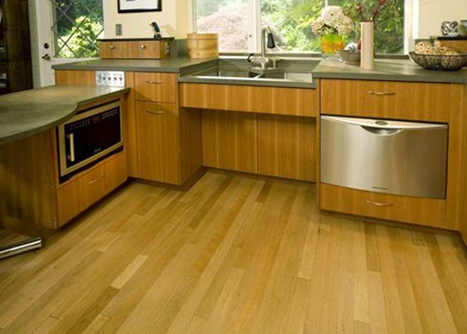
There are three categories of Aging in Place customers. Those who are simply and wisely planning for their futures to remain in their present homes. The second category concerns those who know they have a chronic medical disorder and need to prepare for accessibility issues resulting from their disease. People with diseases constantly causing increased physical or mental changes to their being are a good representative of this second group. The third group involves those who either have had a chronic problem that has progressed severely altering their mobility or those who have sustained a life-altering tragedy such as being involved in an accident. All of these groups will drive the future metamorphosis of existing inaccessible dwellings.
During a professional home assessment for increasing accessibility, the structural needs of the clients will be noted and documented through sketches, photos, and conversation by a registered CAPS professional. All the surroundings will be considered, from the flooring to the layout of a specific room or location as it pertains to each inhabitant's size or ease of usability. The physical and emotional needs of the occupants will also come into play because of mobility, sensory, or cognitive concerns. Each individual with similar impairments describes his or her limitations differently when undergoing elder construction. The blind don't experience their world the same as a person with deafness. The ultimate goal is to modify the home in a custom manner to provide for the occupant's maximum health, independence, and safety. Often the input from any caretakers, like a physical or occupational therapist, during the assessment phase can prove invaluable. The three main rooms involved in aging in place home modifications are the bathrooms, the kitchen, and the family room. These areas make up the most occupied spaces of any home and will be connected by a designated accessible route. The basic needs involve access through wider doorways, nonslip floor surfaces, and adequate cabinet and plumbing fixture accessibility. More importantly, we must observe safety for everyone as the baby boomers choose to age in place within their homes. For more information about T-Square Company or Aging in Place services, visit www.tsquareco.com or call 512-444-0097. We are a certified Aging in Place contractor (#1636580).
Knowledgeable construction and design professionals are utilizing their CAPS training across the nation. CAPS stands for Certified Aging In Place Specialist. This designation is taught through the National Association of Home Builders in collaboration with AARP. CAPS connects responsible professionals with homeowners who need these services ever-increasingly. The CAPS designation program is a nationwide initiative, and all active CAPS members can be found at nahb.org/CAPSdirectory.
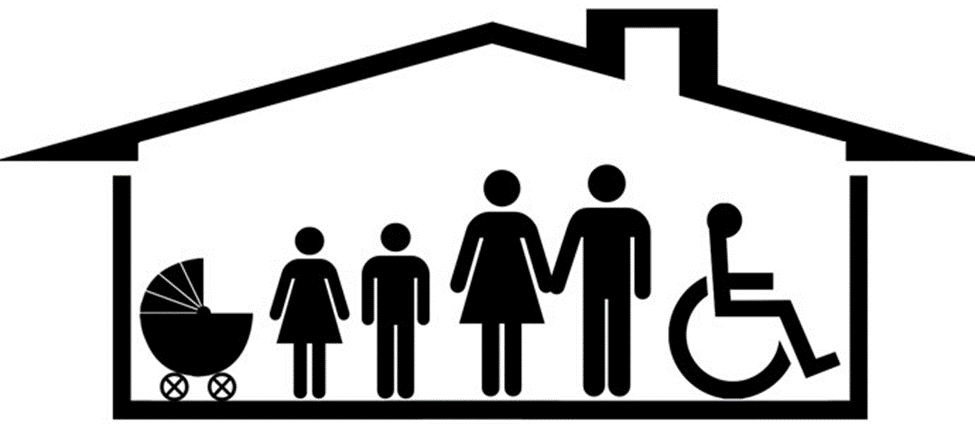

If children are moving into your home, their size and ability are major considerations for the Universal Design. In designing for specific physical conditions for an adult moving into your home, we realize that aging doesn't always bring on disease while the body declines to make certain physical limitations inevitable. Arthritis is the most common chronic condition as it restricts ordinary daily activities. The lack of hand strength and stiff knees are indicative of this illness. This most reported arthritic condition affecting people over 65 is followed by heart disease and vision loss in that order. Innovative aging design and concepts can compensate for frailty, lack of mobility, and blindness in Aging in Place extended families. We are constantly coming up with new methods for home modifications and household products to increase the comfort of our residential environments.
David L. Traut, CAPS, the owner of T-Square Company in Austin, Texas, is one of the select group of professionals nationwide to earn the Certified Aging-In-Place Specialist (CAPS) designation, identifying him as a home remodeler and builder with the skills and knowledge necessary to remodel or modify a home to meet the unique needs of the older population, disabled owners, or their visitors. We offer a complete line of aging in place services using our design/build techniques and the principles of Universal Design. Everything we do is done on a customized turnkey basis.
After over a year of writing to fulfill my customers' requests, my new book, "Age in Place At Home," is finally available for purchase from Amazon. Go to the link below to order my paperback book, which was released in late November, 2022. It provides a great guideline for using the principles of Universal Design in new home construction and/or remodeling for every room in your home. Get your copy today.
https://www.amazon.com/gp/r.html?C=2Z24ENUUAEWUK&K=13Y7YU7PKKYAC&M=urn:rtn:msg:20221010201802eb9acb7b24004a4785cd2ec1d4f0p0na&R=3R6MK9WDXJPH7&T=C&U=http%3A%2F%2Fwww.amazon.com%2Fdp%2FB0BHTV28RV%3Fref_%3Dpe_3052080_276849420&H=7FWEPMGCH0TT8LN6SKPMUOCVJNYA&ref_=pe_3052080_276849420
A home's adaptability is one of the most desired qualities within a person's home during some point in their life as their or their family's personal needs change. Specific needs to enhance a home's accessibility can be short term while recovering from an accident or illness at any age, or these home alterations may become permanent. The special needs may concern an adult or a child. Universal design principles don't discriminate between any family members regardless of age, size, or ability. Every family member is included. Learn how to adapt your home environment to satisfy your family's needs in David Traut's new book, "Age in Place at Home".

Tags:
barrier free access,
aging in place remodeling,
CAPS,
aging in place home improvements in Austin,
CAPS certification,
ADA remodeling,
CAPS certified remodeling in Austin,
aging in place remodels,
aging in place construction,
aging in place designs,
CAPS professional in Austin,
CAPS certification holder in Austin,
CAPS remodeling techniques,
Universal Design,,
aging in place services,
aging in place design,,
certified aging in place specialist,
disability home modifications in Austin,
home modifications Austin, Texas,
wheelchair accessible showers in Austin,,
handicap bathrooms,
roll in showers in Austin,
custom walk in shower Austin,
home remodels Austin,
home modifications for independent living Austin,
certified aging in place consultant in Austin,
aging in place design in Austin,
multigenerational homes
The biggest and most important challenge for any homeowner wanting to increase home accessibility using Universal Design to Age in Place is qualifying a chosen builder or remodeler. Consumers must verify the tradesman or professional has both the experience and knowledge for understanding any requirements used to increase the client’s safety and accessibility within the home. This is the only variable a homeowner controls in the building process. You are about to give a complete stranger your trust in a very serious matter of which you most likely know little about beyond articles read on the internet or hearsay. All professionals selected must be knowledgeable and experienced concerning Universal Design projects. The relevant personnel having job input concerning the client consist of architects, designers, builders, remodelers, and any therapists or extended healthcare workers who are involved with any household occupant requiring home modifications. I have witnessed clients who are completely overwhelmed and frustrated when interviewing several groups of building professionals including subcontractors with overlapping scopes of work. They become confused by the large amount of information gathered. Be advised that too many cooks in the kitchen can spoil a successful job outcome. CAPS certified accessibility specialists are trained to be better capable of helping with both the design and construction phases of the project. Most CAPS members have had coursework in Universal Design. However, you would not choose a recent law graduate over an experienced defense attorney to represent you in a serious matter. Even though both people have law degrees, there is only one path to choose. The remodeling business is no exception. All CAPS certified professionals are not equal. Some come from different professional backgrounds other than construction while others have not used their acquired knowledge long enough to make a difference. Ask about their experience and how long they have practiced Aging in Place remodeling. A well-seasoned contractor has seen what issues frequently come up in making improvements for Aging in Place and knows which methods he or she has used to overcome certain problematic areas of the home.
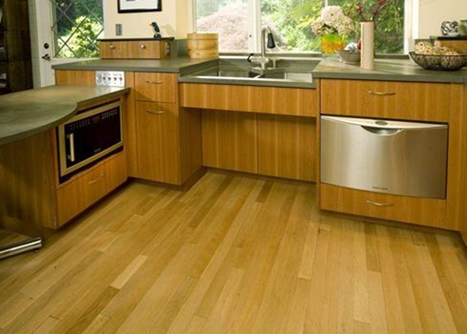
The aging societal changes and inventory of inaccessible existing houses created the need for a CAPS certification program. This designation program, offered through the National Association of Home Builders, NAHB, in collaboration with The American Association of Retired Persons or AARP, incorporates components of assessment, technical knowledge and management skills related to home modifications used to help people stay at home safely and independently for a longer period of time. The program was developed in 2001. The CAPS program connects responsible professionals with home owners needing specialized accessibility services on an ever increasing basis. Ordinary homeowners with extraordinary challenges partner up with experienced CAPS professionals and their own families. Working as a team, the trained CAPS specialist along with any family caretakers or therapists is able to identify the day to day problems weighing on those with health limitations. Aging in Place services provided by a specialized remodeling contractor ensures all accessibility issues of the home are accomplished correctly. The CAPS credential is a nationwide initiative and many construction and design professionals are taking advantage of the helpful training across the nation. Always check his or her credentials to verify the remodeler holds an active CAPS certification and is familiar with Universal Design. All registered CAPS program graduates and remodeling companies are listed in a national registry in Washington DC. The information is found by calling 1-800-368-5242 or by simply visiting their website at: http:www.nahb.org/en/learn/designations/certified-aging-in-place-specialist.aspx.

Experienced CAPS certified remodelers have the knowledge, expertise and sensitivity to provide modifications for making a home safer, more accessible, and better suited to the client’s required needs. A professional CAPS certified builder or remodeler is able to correctly assess the costs associated with an accessible design and lead the homeowner in the right direction adhering to the available budget costs to accomplish the modifications needed. Home modifications, accessibility products, and barrier free design greatly promote the independence and functional ability of physically challenged and aging individuals. Designing around specific physical conditions for accessibility lessens the impact of arthritis, restricted mobility, or loss of vision by using combinations of products, concepts, and techniques available today. Keep in mind when hiring a Certified Aging in Place Specialist they offer a service rather than a product. Each CAPS member draws from a different knowledge base, and approaches each project in a distinct way.
T-Square Company in Austin, Texas, has been producing successful Aging in Place projects for over a decade. They are a CAPS certified remodeler and offering design/build Aging in Place projects using Universal Design features. Call 512-444-0097 to discuss your project today and learn how you can achieve better accessibility within your existing home.
Incidentally, David L. Traut, the President/owner of T-Square Company has recently published a book entitled "Age in Place at Home: Adapting the Home Environment for All Generations". It is available on Amazon and stands as a reference book for increasing home accessibility incorporating essential Universal Design features.

Tags:
aging in place remodeling,
aging in place home modifications,
handicap home modifications,
CAPS certified remodeling in Austin,
ADA compliance,
custom tub to shower conversions,
CAPS remodeling techniques,
Universal Design,,
aging in place services,
certified aging in place specialist,
accessibility designs Austin Texas,
home modifications for independent living Austin,
universal design ideas,
certified aging in place consultant in Austin,
age in place home design,
aging in place home remodeling,
7 principles of universal design,
Austin disability contractors for special needs,
Austin handicap bathroom contractor,
barrier free remodeling,
handicap accessible home modifications,
disability remodeling,
ADA compliant wheelchair accessible showers,
accessible bathroom remodel,
why universal design,
accessible homes in austin,
the basics of aging in place,
Austin home modification services,
Age in Place at Home,
Professional Disability Remodeling Contractor,
CAPS-certified remodeling in Dripping Springs,
Universal Design for Disabilities,
Barrier-free designs,
home accessibility help
Let's face it, accessible homes are needed by all of us at some time during our lives. This is true whether it's for ourselves, a family member, or a guest. The need for handicap remodeling is certainly not driven by age but is a result of life's experience. Any family living with disability among any of it's generations within the group can always benefit from additional accessibility. This will in turn increase safety and independence for all people involved as they go about life. Except under extreme situations, complete ADA-compliance normally isn't required for a remodel used to increase residential accessibility. The ADA rules are a great place to begin a design when dealing with a lack of home accessibility. However, any and all compliant items are a great help for everyone. The ADA specifications deal with explicit measurements, but these stringent rules do not apply to many people. Diverse body sizes and abilities are overlooked, and everyone is dealt with on average. More so, only if modifications involve government backed housing and funding are the ADA guidelines followed to the letter. In other words, the guidelines aren't a consideration when dealing with a single private family residence. So how did the ADA guidelines come about?
During the 1960's, the Americans with Disabilities Act (ADA) was signed into law, protecting the civil rights of those with disabilities. This law was merely a beginning, acknowledging a part of our population was dealing with disabilities. Although this law did not directly address disabilities per se, it served as a foundational piece of civil rights legislation. Disability advocates applied the language used in the Civil Rights Act for later legislation concerning civil rights for those with disabilities. Later on, the Americans with Disabilities Act, also known as ADA, as we know it today began. First implemented in 1990, it was our government’s first step toward addressing the needs of citizens living with disabilities. Yet as technology and our culture evolved, so did the challenges faced by disabled Americans. Accessibility became a hurdle not only in the physical world but also the vast digital realm of today. The law is constantly evolving while changing with the times; thereby making everyday life easier for individuals with unique needs.
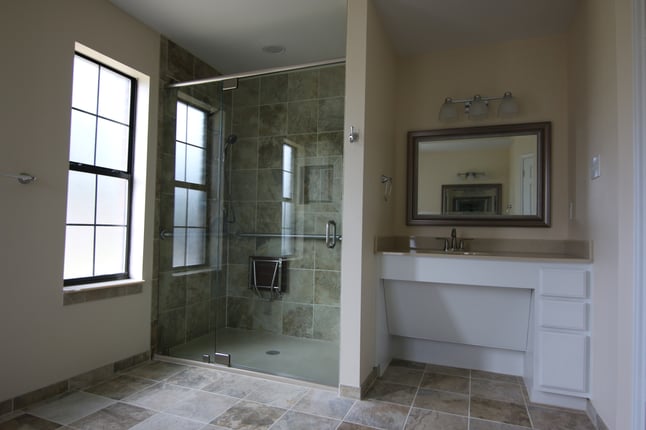
Disability is a complex phenomenon representing an interaction between one's physical impairments, the activities they need to perform, and the architectural barriers within the space in which this situation occurs. The terminology and jargon used for disabilities evolves regularly whereas, "handicapped" is no longer acceptable. It is no longer merely a description of intellectual or physical impairments. Each individual with similar impairments describes his or her limitations differently. The blind don't experience their world the same as a person with deafness and so on. Physically challenged has become the more socially accepted description of a person with an impairment, regardless of age. No matter how old you are, you should periodically evaluate your residence to determine whether it suits you not just for the present but the future. Your personal home assessments will be revised every time your living situation changes. Whether childproofing for a newborn, making a home more accessible following a sickness or unfortunate accident to someone in the family, or making a toilet area safer for an aging residing parent, there will be an immediate evolution to your primary domicile. These same life-span design features become more important if you believe you're past the age of wanting to move and are relishing the thought of aging in your own home, no matter what physical limitations you might later develop. This way of thinking has created a niche residential market known as Aging in Place. Solving Aging in Place issues will soon become the number one challenge concerning the present obsolete housing inventory in our country. Incorporating smart aging design concepts like a roll-in-shower into a home will attract a larger group of buyers when you decide to finally sell your home. Preparing for one of those highly likely events involving someone in your home needing room modifications for even a short time while recovering from surgery is surely a wise move.

In our daily lives, we all know what to do if the front door is no longer secure, if the kitchen sink backs up, or if the air conditioning suddenly goes out on a hot day. However, for those suddenly facing a catastrophic illness, life can suddenly be a scary and confusing place in which our existing homes are no longer a sanctuary but become a prison within the nightmare of limited accessibility. With the onset of a life-altering illness or catastrophic injury, knowing who to call to solve problems faced performing our usual daily tasks suddenly becomes very challenging.
Knowledgeable construction and design professionals are utilizing the CAPS training across the nation. CAPS stands for Certified Aging In Place Specialist. This designation is taught through the National Association of Home Builders in collaboration with AARP. CAPS connects responsible professionals with home owners who need these services on an ever-increasing basis. CAPS is a nationwide initiative and all active CAPS members can be found at nahb.org/CAPS. Look for the CAPS designation as a reliable way to identify professionals to modify your home or build a new forever home that is designed for a lifespan. CAPS graduates receive training about the technical/construction aspects and learn about the unique aspects of working with older Americans. They must take formal business training to maintain their credential through continuing education and subscribe to a Code of Ethics.
David L. Traut, CAPS the owner of T-Square Company in Austin, Texas is one of the select group of professionals to earn the Certified Aging In Place Specialist (CAPS) designation, identifying him as a home remodeler and builder with the skills and knowledge necessary to remodel or modify a home to meet the unique needs of the older population, disabled owners, or their visitors. T-Square Company offers a full compliment of Aging in Place services including bathroom modifications for elderly clients with special needs. Each design/build project will be customized to fit your personal needs increasing your accessibility. Call 512-444-0097 today to begin the accessible second chapter of your life while remaining safe and secure in your existing home. CAPS #1636580
As an answer to his clients requests over the years, David has recently published a book entitled "Age in Place at Home: Adapting the Home Environment for All Generations". The book reflects on thirty years of accessibility improvements and identifies why our traditional homes specifically lack this very basic need. It is available on Amazon and stands as a reference book for increasing home accessibility using the principles of Universal Design in every room of the home.
Tags:
ADA remodeling,
CAPS certified remodeling in Austin,
ADA compliance,
aging in place services,
elder construction,
certified aging in place specialist,
disability home modifications in Austin,
home modifications Austin, Texas,
wheelchair accessible showers in Austin,,
roll in showers in Austin,
home modifications for independent living Austin,
disability access bathrooms Austin,
disability remodeling in Austin,
universal design/build ideas,
Austin Accessibility Design,
Austin senior living solutions,
Austin accessible home remodeling,
Austin disability contractors for special needs,
Austin handicap bathroom contractor,
Austin home remodeling for disabled,
Disability Remodeling Services in Austin, Texas,
ADA Accessibility,
ADA Contractor/Austin, Texas,
Dripping Springs home accessibility solutions,
Dripping Springs special needs contractor,
Dripping Springs aging in place specialist,
Universal design construction in Austin,
Universal Design for Disabilities,
Barrier-free designs
If you have made a decision, along with the support of your family, to remain in your existing home while you Age in Place, you must determine a definite pathway forward to ensure your desires are successfully met. This is a sign of the times as today over 80% of homeowners share your desire to remain in their familiar home, surrounded by familiar surroundings and neighbors. Amongst any caregivers involved in your life, you will also need to obtain help from a trained and seasoned Certified Aging in Place Specialist.
Fortunately, construction and design professionals are taking advantage of the CAPS training across the nation. This designation is taught through the National Association of Home Builders in collaboration with AARP. CAPS connects responsible professionals with home owners who need these services on an ever-increasing basis. CAPS stands for Certified Aging in Place Specialist. It is a construction credential that has builders, architects, remodelers, designers and even occupational therapists buzzing. Aging in Place principles are changes designed to custom fit your existing home to you and your family's needs as time goes by. CAPS design takes your current and future circumstances into consideration and the principles focus on elegant, aesthetically enriching, barrier-free environments. Home modifications do not need to look institutional and this is why many seniors are resisting the very changes that can help them the most. Be aware, the vast majority of uncertified builders and remodelers do not have the knowledge and training to perform home modifications for Aging in Place. Take for instance when you are considering installing a grab bar, which seems like a simple endeavor, understand that a run of the mill contractor or handyman has no idea of the safety regulations involved or the knowledge concerning where and how to install the grab bar. This leaves the consumer in an unsafe predicament. However, if performed correctly, any modifications will actually increase the value of your home because they appeal to multiple generations of home buyers.
David L. Traut, CAPS the owner of T-Square Company in Austin, Texas is one of the select group of professionals to earn the Certified Aging In Place Specialist (CAPS) designation, identifying him as a home remodeler and builder with the skills and knowledge necessary to remodel or modify a home to meet the unique needs of the older population, disabled owners, or their visitors. T-Square Company offers a full compliment of Aging in Place services for their clientele. These services include the initial home assessment, a design followed by a detailed drawing, all city permits and fees, and the construction or remodeling work involved. David has been successfully operating as a CAPS professional for nearly thirty years while performing his design/build projects. His clients include many members of the private sector, the VA, and HUD. David is a CAPS certified remodeler and master builder providing a one-stop-shop which is even more valuable to anyone wanting to Age in Place. As a master craftsman, his construction knowledge enables any Aging in Place design to come to fruition via practicality and best practices.

David always practices what he preaches to his clients. He takes an inductive qualitative research approach with every client, because everyone has diverse physical needs. As an answer to his clients requests over the years, he has recently published a book entitled "Age in Place at Home: Adapting the Home Environment for All Generations". The book reflects on thirty years of accessibility improvements and identifies why our traditional homes specifically lack this very basic need. It is available on Amazon and stands as a reference book for increasing home accessibility using the principles of Universal Design in every room of the home. David is certified in the United States and Australia in the Universal Design process. Universal Design elements can be installed into a home at any time avoiding the need for reactive remodeling following a health crisis. This thoughtful proactive design process segues seamlessly into what is required for Aging in Place. Furthermore, Universal Design prevents the need to perform future modifications except under extreme circumstances. The presence of Universal Design provides access for both wheelchairs and walkers and perhaps avoids future injuries because you have accessibility.

For additional information about the CAPS program, visit nahb.org/CAPS. For more information about T-Square Company, visit www.tsquareco.com or call 512-444-0097 to schedule a home assessment by a local Austin CAPS professional.
So, just exactly what takes place once you schedule a home assessment? During the home assessment for increasing accessibility, the structural changes needed for the client will be noted and documented through sketches, photos, and conversation. CAPS professionals are generally paid by the hour or receive a flat fee per initial visit or project because they are offering a service backed by education and experience. Typically an assessment takes approximately 60-90 minutes. It’s best if you or a family member can accompany the CAPS professional during the home safety assessment, as you or they can ask questions about specific safety items as they come up. The comprehensive Home Safety Assessment determines a direct and safe path forward for you, the client. You will have a better chance of avoiding the high cost and physical disruptions of future injuries leading to assisted living. All the surroundings within your home will be taken into account from the flooring to the layout of a specific room or location as it pertains to the your ease of use. Your physical and emotional needs also come into play because of mobility, sensory, or cognitive concerns. The goal is to modify the home in a custom manner to provide for your maximum health, independence, and safety. Often the input from any caretakers like a physical or occupational therapist during the assessment phase can prove to be invaluable. The three main rooms involved in Aging in Place home modifications are the bathroom, the kitchen, and the family room in that order. The basic needs involve access through wider doorways, level non-slip floor surfaces, and lower cabinets with plumbing fixture accessibility like roll-under sinks with easily operated lever controls.
Aging in Place Bathroom Modifications in Austin
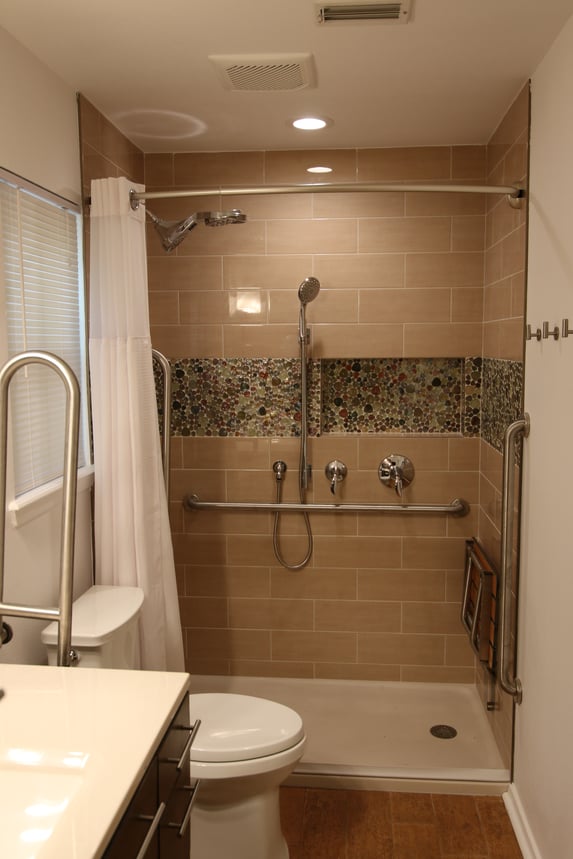
Quite often it is the home that presents the greatest difficulties for homeowners accompanied by limited mobility or other physical impairments as they age in their existing surroundings. Designing for specific physical conditions will lessen the impact of arthritis, restricted mobility, or loss of vision by using combinations of products, concepts, and techniques available today. Keeping safety in mind, interior modifications commonly include adding grab bars or handrails throughout the home, installing ramps or vertical platform lifts, lowering upper cabinets and countertops to Universal Design heights, adding non-slip flooring, widening hallways or installing stairlifts, and widening doors. You might also consider lowering light switches and thermostats and installing easier-to-use door levers or electric door openers. Try to provide a clear barrier-free path or accessible route to the most visited areas of your home like a disability access bath containing a roll-in ADA compatible shower, the kitchen, and the family room.

Tags:
barrier free access,
CAPS certification,
CAPS certified remodeling in Austin,
aging in place construction,
CAPS remodeling techniques,
disability home remodeling in Austin,
aging in place services,
aging in place design,,
elder construction,
certified aging in place specialist,
Austin elder construction,
handicap home modifications for disabled,
handicap remodeling contractors,
roll in showers,
handicap bathrooms,
universal design/build,
Austin Accessibility Design,
Austin senior living solutions,
Austin accessible home remodeling,
certified aging in place consultant in Austin,
bathroom modifications for disabled in Austin, TX,
aging in place specialist in Austin,
senior aging in place services,
home modifications for children with disabilities,
what does it mean to age in place,
aging in place home remodeling,
home remodeling for disabled in Austin Texas,
wheelchair accessible home remodeling in Austin,
austin texas wheelchair accessible showers,
home remodeling for seniors Austin,
Austin Senior Home Remodeling,
remodeling for elders in Austin,
disability and special needs contractor Austin,
bathrooms with disability access in Austin, Texas,
Austin disability contractors for special needs,
Austin handicap bathroom contractor,
handicap accessible remodeling,
barrier free remodeling,
handicap accessible bathroom remodeling,
handicap accessible home renovations,
handicap accessible home modifications,
disability remodeling,
handicap accessible bathroom remodel,
Austin aging in place specialist,
what is aging in place,
Age in Place at Home,
Disability Remodeling Services in Austin, Texas,
disability and special needs contractors in Austin,
universal design and accessibility in Austin,
Barrier-free designs,
forever home,
home accessibility help
It's not for everyone, but as more and more older Americans choose to Age in Place while remaining in their homes, issues related to maintaining mobility, promoting home safety and creating an environment to meet care needs are becoming increasingly important to both caregivers and care recipients. According to the AARP nearly 90% of older adults want to Age in Place and maintain independence; however, 85% have done nothing in preparation for it. Many retirees want to stay living in their own house for as long as possible. But being able to do so will depend on how easy it is to maneuver throughout their home as they get older. A plan for Aging in Place must be put into place as soon as possible to avoid mishaps. Research by the Centers for Disease Control and Prevention show that applying the correct Aging in Place home modifications per individual client need may prevent up to 50% of home accidents among seniors in older homes including falls.

Once families are suddenly thrust into the responsibility of caring for an aging, ill or injured family member, knowing how to make their home accessible, barrier-free and safe can be challenging. Even families that are savvy and experienced about these issues may have trouble figuring out whom to call for a roll-in-shower, ADA-compatible kitchen, or a door widening. Do not fear, there is knowledgeable and experienced help for this matter locally available.
The National Association of Home Builders, in partnership with the AARP and Home Innovation Research Labs, created the CAPS program, which includes training and education on the technical, business management and customer service skills essential to compete in the fastest growing segment of the residential remodeling industry--home modifications for aging in place. David L. Traut, CAPS, the President and owner of T-Square Company in Austin, Texas, is a handicap remodeling contractor professionally practicing his craft for nearly thirty years. He is one of the select group of professionals nationwide to earn the Certified Aging-In-Place Specialist (CAPS) designation, identifying him as a home remodeler and builder with the skills, training, and knowledge necessary to design and remodel or modify a home to meet the unique needs of the older population, disabled owners, or their visitors. He incorporates the principles of Universal Design into all his design/build projects. T-Square Company specializes in home modifications for seniors.
By the way, David has recently published a book entitled "Age in Place at Home: Adapting the Home Environment for All Generations". It is available on Amazon and stands as a reference book for increasing home accessibility using the principles of Universal Design.

Home renovations for Aging in Place positively affecting a homes interior design include adding non-slip flooring, widening hallways or installing stair lifts, and widening doors. You should also consider lowering light switches and thermostats and installing easier to use door levers. Many considerations for an Aging in Place design should be taken into account to provide safety and independence. Always provide a clear barrier-free path or accessible route to the most visited areas of the home as recommended by the ADA. The three areas needing improvement for a person wanting to Age in Place include the bathroom, the kitchen, and the family area in order of importance. ADA compliant kitchen cabinets and ADA bathroom cabinets will more than likely come into play to complete any accessible home remodeling project.
Furthermore, due to the inaccessibility of existing traditional homes, people interested in Aging in Place services are looking for a level entry into their home along with the maneuverability that a more open floor plan having greater clear unobstructed floor space presents. They desire flat non-skid floors without transitions requiring steps or stairs to move around. If ramps are used to overcome stairs within the design, they have a correct 1:12 slope or less. The ramps can be used to get the homeowner up to the level floor space at the exterior entries or the garage access.
Wheelchair Accessible Kitchen In Austin
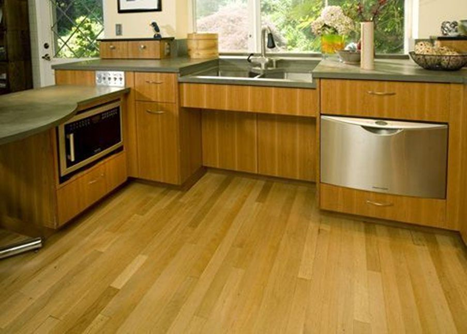

Let's compare the alternative costs associated with Aging in Place when you already own your home verses moving away from familiar surroundings and neighbors. The more institutional alternative of assisted living accompanied by more medical expertise and staff training plus the access to emergency medical facilities is available as opposed to renting an apartment. These are two of the main alternative choices for seniors who decide not to remain in their own homes. According to a national study done in 2021, the average cost for assisted living ranged from $4,000 to $5,500 per month. However, if you decide to Age in Place in a high quality one bedroom apartment, the rent will run around $2,500 per month. Living in your own home or with loved ones represents a preference by most seniors and property taxes must be taken in account. In this case, there is also the positive effects of home equity being available to fund the required home modifications. But what are the costs involved?
An average Aging in Place master bathroom/bedroom suite modification intended to provide total accessibility will come in around $35,000, given there is a large enough space to remodel at onset. This can vary in many aspects if there is not enough room to change the existing floor plan. Smaller bathrooms can cost $15-20,000 to modify; but generally will not have the barrier-free accessibility compared to the larger modified bathroom. Fully accessible kitchens cost on the average of $50,000 to modify, depending on the size and layout of the existing kitchen. These are both one time costs for sustainability of a given lifestyle and location providing future independence and safety for the homeowner who participates in accessible home remodeling.
All disability home remodeling or disability bath remodels in Austin must be done considering all the data provided by the client, his or her family, and any caretakers involved. Aging in place design must be carried out by an Aging in Place specialist who is also a reputable residential remodeling professional. The goal of an accessible bathroom design in Austin is to make the bathroom a safer space for everyone who uses the facilities. Aging in Place services use Universal Design to accommodate wheelchair use and can make the bathroom more comfortable for all generations with or without specific needs. If a design allows wheelchair use, it also allows greater accessibility for everyone universally.
For additional information about the CAPS program, visit nahb.org/CAPS. For more information about T-Square Company, visit www.tsquareco.com or call 512-444-0097 to schedule a home assessment by a CAPS professional.
Tags:
barrier free access,
aging in place remodeling,
aging in place home modifications,
ADA remodeling,
ADA bathroom cabinets,
ADA kitchen cabinets,
aging in place designs,
accessibility home remodeling in Austin,
CAPS professional in Austin,
CAPS certification holder in Austin,
CAPS remodeling techniques,
disability bathroom remodeling in Austin,
bathroom modifications for elderly,
aging in place specialist,
aging in place services,
elder construction,
certified aging in place specialist,
handicap remodeling contractors in Austin,
independent living in Austin Texas,
senior aging in place services
Disability is a complex phenomenon representing an interaction between one's physical impairments, the activities one needs to perform, and the architectural barriers within the space in which this situation occurs. Each individual demonstrates the complexity with similar impairments describing his or her limitations differently. The blind don't experience their world the same as a person with deafness. Some of our societal statistics that weigh into Aging in Place situations include reports stating that 19% of the population between the ages of 16 and 64 and 42% of those of us 65 and over have a physical disability affecting the activities of their daily lives.
The situation holds true for adults, and for children with special needs. The building world must work in unison to be sure the entire living environment meets basic needs in addition to affordability and structural integrity for the consumer and homeowner. This includes the home and the components within the home being accessible to all inhabitants needing it most once architectural barriers become a recognized problem for any particular family member regardless of age or ability. Privacy, a sense of belonging, a sense of control, and the sense of safety and security make up the quality of life for any home and should be considered for any barrier-free design.
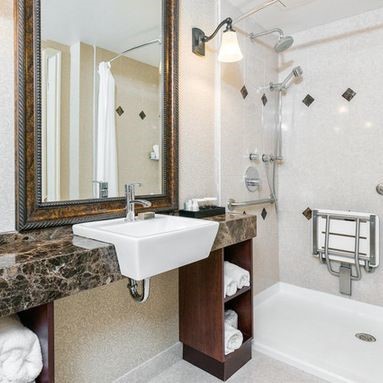
Traditional homes are commonly full of barriers restricting maneuverability for anyone with a disability. This situation is accentuated once any mobility device is required. Houses typically exhibit home entrances involving steps, narrow doorways, tight hallways with abrupt turns, cramped bathrooms inhibiting comfortable fixture use, inaccessible outside amenities, congested and unfriendly kitchens, and door locking hardware requiring hand strength and coordination.
The concept of the accessible home has evolved beyond the basic grab bars and ramps to one in which accessibility is built into the basic design. Everyone ages differently and has different needs and wants. These factors have brought about the need for Universal Design. This is the design of products, services, and environments usable by as many people as possible regardless of age, ability, or situation without needing adaptation or specialized alterations. It provides the most significant safety and access for home guests or occupants and is undetectable when done well. The principles of Universal Design enable living in a home with more comfort and adaptability for people of all ages and abilities.

Fortunately for people needing increased accessibility beyond what their existing home offers, there is home accessibility help available in Austin, Texas, offered by T-Square Company. T-Square Company specializes in handicap accessible homes and barrier-free remodels having over 30 years of accessibility experience. They provide customized disability home modifications for any age resident with special needs. T-Square Company offers a complete assortment of disability services to help cushion and adapt to any disability including barrier-free home design/build projects. Wider entries and hallways, accessible bathrooms and showers, accessible kitchens, ramped entrances, vertical platform lifts, stair lifts, elevators, and accessible rooms of any type are just a few of the services offered. Every design is based on the specific needs and abilities of the client.
David L. Traut, CAPS the owner and president of T-Square Company in Austin, Texas is one of the select group of professionals nationwide to earn the Certified Aging in Place Specialist (CAPS) designation, identifying him as a home remodeler and builder with the skills and knowledge necessary to remodel or modify a home to meet the unique needs of the older population, disabled owners, or their visitors. Additionally, he is certified in Universal Design in the United States and Australia. David has recently published a book called "Age in Place at Home: Adapting the Home Environment For All Generations". The book explains the importance of Universal Design in building taking you through every room of the home in order to increase home accessibility. It is available on Amazon.
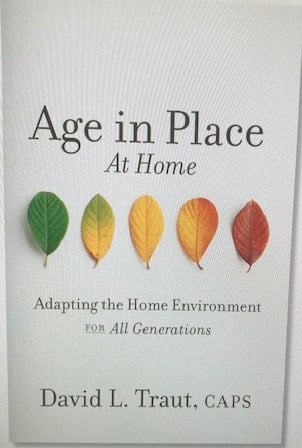
Never fear. You can adapt almost any existing home environment to overcome difficulties and enable you and everyone else in the family to comfortably live at home and move around safely with correct planning and know-how.
Your quality of life will improve if you follow the book's advice. The positive result is every family member has equal accessibility throughout your home's interior. IT JUST MAKES GOOD SENSE.

Tags:
handicap home modifications,
disability home remodeling in Austin,
elder construction,
certified aging in place specialist,
handicap accessibility,
disability and special needs contractor Austin,
bathrooms with disability access in Austin, Texas,
barrier free remodeling,
disability access contractor,
barrier free design,
disability and special needs in dripping springs,
increase home accessibility,
barrier-free remodels
When families are suddenly thrust into caring for an ill or injured family member, knowing how to make their homes accessible, barrier-free and safe can be challenging, especially when it involves an aging parent. A professional CAPS-certified remodeler is needed to offer guidance and solutions to the discovered family problems. Aging in Place is not for everyone, but as increasingly older Americans choose to Age in Place and remain in their homes, issues related to maintaining mobility, promoting home safety, and creating an environment to meet care needs are becoming increasingly crucial to caregivers and care recipients, along with the building community. Even savvy and experienced families may have trouble figuring out whom to call for a roll-in shower or door widening. According to the AARP, nearly 90% of older adults want to Age in Place and maintain independence however, 85% have done nothing about it. Many retirees want to stay in their own houses for as long as possible. But being able to do so will depend on how easy it is to maneuver your home as you age. Research by the Centers for Disease Control and Prevention shows that Aging in Place home modifications may prevent up to 50% of home accidents among seniors in older homes, including falls. T-Square Company is a certified disability access contractor in Austin, Texas, doing accessibility jobs for the VA, HUD, and the private sector for nearly thirty years. T-Square Company offers a complete line of Aging in Place services using their design/build approach. T-Square Company's Aging in Place services incorporate the principles of Universal Design to better accommodate wheelchair users or people with varying disabilities, making the home environment more comfortable for all generations with or without specific needs.

The National Association of Home Builders, in partnership with the AARP and Home Innovation Research Labs, created the CAPS program, which includes training and education on the technical, business management, and customer service skills essential to compete in the fastest-growing segment of the residential remodeling industry--home modifications for Aging in Place. David L. Traut, CAPS, the owner of T-Square Company in SW Austin, Texas as a handicap remodeling contractor, is one of the select group of professionals nationwide to earn the Certified Aging-In-Place Specialist (CAPS) designation, identifying him as a home remodeler and builder with the skills, training, and knowledge necessary to design and remodel or modify a home to meet the unique needs of the older population, disabled owners, or their visitors. David is certified in Universal Design in the United States and Australia. He has recently published a book entitled "Age In Place At Home: Adapting the Home Environment For All Generations". It is available through Amazon. It acts as a guidepost for accomplishing better accessibility throughout the home. He takes you room by room showing you how you can make your home inclusive to everyone living there and for all visitors.

ADA-Compliant Kitchens
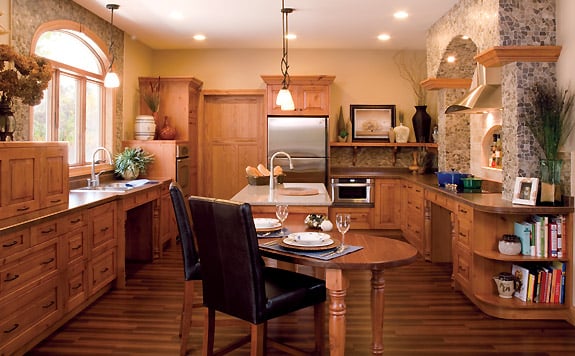
People interested in Aging in Place services and Aging in Place home improvements are generally looking for a level entry into their home along with the clear maneuverability that a more open floor plan with more extraordinary clear unobstructed floor space presents. They desire flat floors without transitions requiring steps or stairs to move around. Ramps having a correct 1:12 slope or less can be used to get them up to the level floor space at the exterior entries or the garage entrance. ADA-compliant kitchen cabinets and ADA bathroom cabinets will more than likely come into play to complete any accessible home remodeling project. Aging in Place services and home modifications should include adding non-slip flooring, widening hallways or installing stair lifts, and widening doors. You might consider lowering light switches and thermostats and installing easier-to-use lever door hardware. To provide safety and independence, many considerations for an Aging in Place design should be considered. Provide a clear barrier-free path or accessible route to the most visited areas of the home, as the ADA recommends. The three areas needing improvement for a person wanting to age in place include the bathroom, the kitchen, and the family area in order of importance. The goal of an accessible design in Austin is to make the areas in the home a safe space for everyone who uses the facilities, regardless of age, size, or ability.

For additional information about the CAPS program, visit nahb.org/CAPS. For more information about T-Square Company, visit www.tsquareco.com or call 512-444-0097 to schedule a home assessment by a CAPS professional.
Tags:
barrier free access,
aging in place remodeling,
aging in place home modifications,
ADA remodeling,
ADA bathroom cabinets,
aging in place remodels,
ADA kitchen cabinets,
aging in place construction,
aging in place designs,
accessibility home remodeling in Austin,
CAPS professional in Austin,
CAPS certification holder in Austin,
CAPS remodeling techniques,
disability bathroom remodeling in Austin,
bathroom modifications for elderly,
aging in place specialist,
aging in place services,
aging in place design,,
elder construction,
certified aging in place specialist,
handicap remodeling contractors in Austin,
independent living in Austin Texas,
aging in place specialist in Austin,
senior aging in place services,
Austin aging in place specialist,
barrier free design,
Age in Place at Home,
Professional Disability Remodeling Contractor,
aging in place services for seniors in Austin
When families are suddenly thrust into caring for an ill or injured family member, knowing how to make their homes accessible, barrier-free and safe can be challenging. Here is where a professional CAPS-certified remodeler is needed. It's not for everyone, but as increasingly older Americans choose to Age in Place and remain in their homes, issues related to maintaining mobility, promoting home safety, and creating an environment to meet care needs are becoming increasingly crucial to caregivers and care recipients. Even savvy and experienced families may have trouble figuring out whom to call for a roll-in shower or door widening. According to the AARP, nearly 90% of older adults want to Age in Place and maintain independence however, 85% have done nothing about it. Many retirees want to stay in their own houses for as long as possible. But being able to do so will depend on how easy it is to maneuver your home as you age. Research by the Centers for Disease Control and Prevention shows that Aging in Place home modifications may prevent up to 50% of home accidents among seniors in older homes, including falls.

The National Association of Home Builders, in partnership with the AARP and Home Innovation Research Labs, created the CAPS program, which includes training and education on the technical, business management, and customer service skills essential to compete in the fastest-growing segment of the residential remodeling industry--home modifications for Aging in Place. David L. Traut, CAPS owner of T-Square Company in SW Austin, Texas as a handicap remodeling contractor, is one of the select group of professionals nationwide to earn the Certified Aging-In-Place Specialist (CAPS) designation, identifying him as a home remodeler and builder with the skills, training, and knowledge necessary to design and remodel or modify a home to meet the unique needs of the older population, disabled owners, or their visitors. T-Square Company offers a complete line of Aging in Place services using their design/build approach.

ADA-Compliant Kitchens

People interested in Aging in Place services and Aging in Place home improvements are now looking for a level entry into their home along with the maneuverability that a more open floor plan with more extraordinary clear unobstructed floor space presents. They desire flat floors without transitions requiring steps or stairs to move around. Ramps having a correct 1:12 slope or less can be used to get them up to the level floor space at the exterior entries or the garage access. ADA-compliant kitchen cabinets and ADA bathroom cabinets will more than likely come into play to complete any accessible home remodeling project. Aging in Place services and home modifications should include adding non-slip flooring, widening hallways or installing stair lifts, and widening doors. You might consider lowering light switches and thermostats and installing easier-to-use lever door hardware. To provide safety and independence, many considerations for an Aging in Place design should be considered. You should try to provide a clear barrier-free path or accessible route to the most visited areas of your home, as the ADA recommends. The three areas needing improvement for a person wanting to age in place include the bathroom, the kitchen, and the family area in order of importance.
All disability home remodeling or disability bath remodels in Austin must be done considering all the data provided by the client, his or her family, and any caretakers involved. Aging in Place design must be carried out by an Aging in Place specialist who is also a reputable residential remodeling professional. The goal of an accessible design in Austin is to make the areas in the home a safe space for everyone who uses the facilities. T-Square Company's Aging in Place services use Universal Design to accommodate wheelchair users and can make the home environment more comfortable for all generations with or without specific needs.

Let's compare the alternative costs associated with aging in place versus when you already own your home. The more institutional alternative of assisted living accompanied by more medical expertise and staff training plus the access to emergency medical facilities is available as opposed to renting an apartment. These are two of the main alternative choices for seniors who decide not to remain in their own homes. According to a national study done in 2019, the average cost for assisted living ranged from $8,000 to $9,500 per month. However, if you decide to Age in Place in a high-quality one-bedroom apartment, the rent will run around $1,700 per month. Living in your own home or with loved ones represents a preference by most seniors and property taxes must be taken in account.
For additional information about the CAPS program, visit nahb.org/CAPS. For more information about T-Square Company, visit www.tsquareco.com or call 512-444-0097 to schedule a home assessment by a CAPS professional.
Tags:
barrier free access,
aging in place remodeling,
aging in place home modifications,
ADA remodeling,
ADA bathroom cabinets,
ADA kitchen cabinets,
aging in place designs,
accessibility home remodeling in Austin,
CAPS professional in Austin,
CAPS certification holder in Austin,
CAPS remodeling techniques,
disability bathroom remodeling in Austin,
bathroom modifications for elderly,
aging in place specialist,
aging in place services,
elder construction,
certified aging in place specialist,
handicap remodeling contractors in Austin,
independent living in Austin Texas,
senior aging in place services























